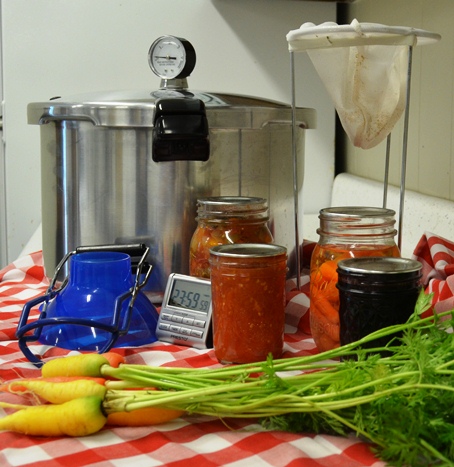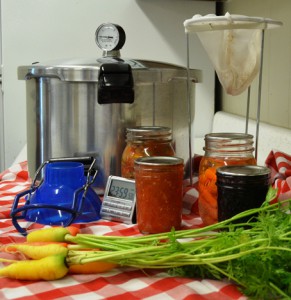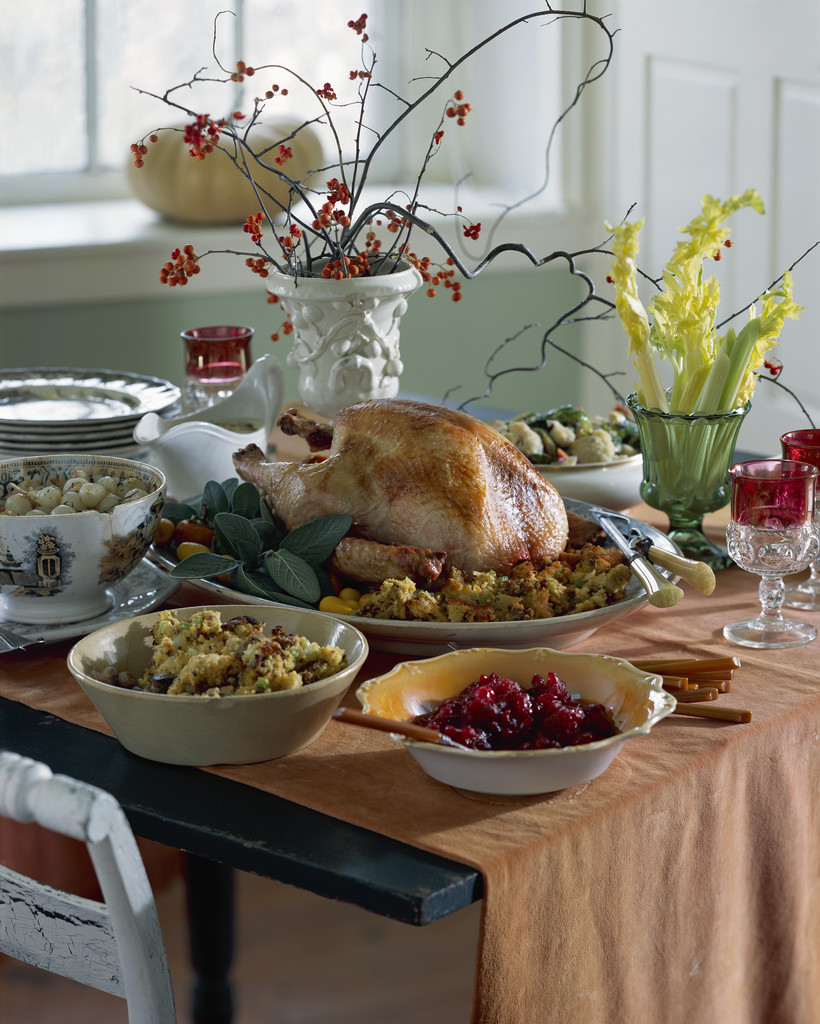
by Shelley Swenson | May 1, 2014

Low-Acid Canning requires a Pressure Canner Submitted by Shelley Swenson/Les Harrison
Home canning has changed greatly in the 170 years since it was introduced as a way to preserve food. Grandma may have cooked her green beans and poured them into hot jars but open kettle canning is not recommended today. Scientists have found ways to produce safe, higher quality products to replace outdated recipes and techniques.
For safety’s sake, pressure canning is the only recommended method for canning meat, poultry, seafood and vegetables. Only through the use of the proper equipment can bacteria be destroyed in low-acid foods when they are processed at the correct time and pressure. Using boiling water canners for these foods poses a real risk of botulism poisoning. If Clostridium botulinum bacteria survive and grow inside a sealed jar of food, they can produce a poisonous toxin. Even a taste of food containing this toxin can be fatal.
What are the secrets of a safe and quality end-product? Process low-acid foods in a pressure canner. Have your gauge checked for accuracy and your gasket for dryness; many county extension offices offer this service. Make sure that you are using up-to date, research-based processing times and pressures for the size of jar, style of pack and kind of food being canned. Utilize the proper processing time and pressure for sterilizing the food at your altitude. Look for jar lids that are firmly sealed and concave and with nothing leaking from the jar after storage. Upon opening the jar, no liquid should spurt out and no unnatural or “off” odors should be detected.
Research-based food preservation recipes and information are available at your county extension office or at the UF/IFAS website http://edis.ifas.ufl.edu/topic_canning_food. When preserving low-acid food there is no room for error. The safety and quality of the end product are factors to be considered.
by Shelley Swenson | Apr 7, 2014

April 26, 2014
9 a.m. to 2 p.m.
Crawfordville, Florida
TCC Wakulla Center and Hudson Park
Come one, come all to the Green Living Expo offered to all citizens of the Big Bend area. I love the adopted tagline… Experience a simpler, more sustainable life. Learn ways to save money and reduce your impact on the Earth.
Those of you who have attended a previous Expo will remember this event is a gathering of all kinds of people who are like-minded in that resource management is a life goal. The event is offered to allow people to share ideas on how to incorporate these sustainable practices into their lives.
The Green Living Expo provides an opportunity for the entire family to attend and spend time as a family in addition to pursuing independent activities based on age and interest.
Activities to be offered:
- Sustainability Workshops
- Bicycle Events
- Green Flea Market
- Green Exhibitors and Products
- Children’s Activities
- Food
- Raffles
Go to www.sustainablebigbend.org or call Wakulla County Extension at 850-926-3931 for more information.
by Shelley Swenson | Dec 18, 2013

Image by © Royalty-Free/Corbis
The countdown is upon us. The last-minute food preparation is soon to begin. Don’t regret the holidays by overdoing in the food consumption aspect of meals. Avoid having to include a strict eating regimen as a new year’s resolution by making some changes in the way you prepare your food. There are ways to cut back during food preparation to spare calories without changing the taste. Consider these suggestions:
- Turkey: Haven’t bought yours yet? Choose a plain bird over a self-basting bird to lower the sodium content. To ensure a moist bird, leave the skin on while roasting, don’t over-bake the bird, and pour gravy on the meat after carving. This isn’t a calorie savings but we have to concern ourselves with sodium intake every day. Consider the latest recommendation from the 2010 Dietary Guidelines for Americans. It is suggested that we reduce our daily sodium intake to less than 2,300 milligrams (mg) and further reduce intake to 1,500 mg among persons who are 51 and older and those of any age who are African-American or have hypertension, diabetes, or chronic kidney disease. The 1,500 mg recommendation applies to about half of the U.S. population, including children and the majority of adults. (Source: Dietary Guidelines for Americans 2010, USDA, www.dietaryguidelines.gov)
- Gravy: Use a fat-skimmer cup or freeze the juices in a shallow pan so you can remove the fat. You will save around 56 grams of fat per cup!
- Dressing: Use a low-sodium boxed stuffing mix and add sautéed onion, celery, apples, and cooked rice. Add a little more broth and bake. Dressing is my favorite part of the meal so I fill my plate with low-calorie vegetables and fruits before the dressing is passed to me to keep my calories under control.
- Candied yams: Sweeten with apple or orange juice and add ground cinnamon. Realize yams have flavor all by themselves. Wean yourself off the butter and marshmallows and enjoy their wholesome taste.
- Green bean casserole: Green bean casserole is a favorite for many people over the decades. Cook fresh green bean with chunks of potatoes and fat-free half-and-half instead of cream soup. Top with almonds and leave the fried onion rings in the cupboard.
- Mashed potatoes: Use skim milk, garlic powder, and a little Parmesan cheese instead of whole milk and butter. Serve low-calorie margarine instead of butter.
- Pumpkin Dessert: Consider serving the pumpkin custard without a pie shell. Individual baking dishes adorned with a small dollop of whipped cream can save calories without sacrificing the taste of a holiday meal favorite.
Ever wondered about the fat content of different meats and poultry that are traditionally consumed over the holidays? USDA offers this summary:
Normal
0
false
false
false
EN-US
X-NONE
X-NONE
/* Style Definitions */
table.MsoNormalTable
{mso-style-name:”Table Normal”;
mso-tstyle-rowband-size:0;
mso-tstyle-colband-size:0;
mso-style-noshow:yes;
mso-style-priority:99;
mso-style-parent:””;
mso-padding-alt:0in 5.4pt 0in 5.4pt;
mso-para-margin-top:0in;
mso-para-margin-right:0in;
mso-para-margin-bottom:8.0pt;
mso-para-margin-left:0in;
line-height:107%;
mso-pagination:widow-orphan;
font-size:11.0pt;
font-family:”Calibri”,”sans-serif”;
mso-ascii-font-family:Calibri;
mso-ascii-theme-font:minor-latin;
mso-hansi-font-family:Calibri;
mso-hansi-theme-font:minor-latin;}
Fat Facts
For a 3.5 ounce serving Grams of Fat
Roast Beef 15.0
Turkey Wing with Skin 12.3
Dark Turkey Meat with Skin 11.5
Roasted Ham 9.0
Turkey Breast with Skin 7.3
Dark Meat without Skin 7.0
Turkey Breast without Skin 0.7
|
Holiday meals don’t have to pack such a high-calorie punch. Simple makeover tips can lighten a meal and keep the taste good!
by Shelley Swenson | May 20, 2013

Salt water continues to make it into our fresh water supply. Will you conserve?
I had the privilege of spending a day recently with children from Medart Elementary School for their annual Project Learning Tree (PLT). During PLT, community representatives make presentations on nature, conservation and sustainability practices. The 2013 theme was Wakulla Life is Nice!
I decided to speak on water conservation since we live in such a wonderful part of Florida with an abundant amount of clean, fresh water. Through an imaginary trip to Wakulla Springs, the children and I noted the clear water and discussed how and why it remains that way. We concluded that we were quite special to have the Springs so close by to enjoy. I reminded them that people visit Wakulla Springs from all over the world to witness the clear, clean water and that water is not that way for many people around the world. I used a poem written by a student who wrote,
“When I look through my water window….
I see lake water for fun.
I see ocean water for surfing.
We’ve got water by the ton!
But when I look a little closer for the part that we can use,
I see we’ve only got a little;
if I waste it – we ALL lose!”
The students were reminded that even if a world map looks like it contains a lot of water or 71% of its surface, 96% is salt water and the other 4% is fresh. When looking at it through this lens, the amount of water on the earth’s surface looks somewhat different. We decided that there was “water, water everywhere, but only a few drops to drink.”
I suggested ways that they might assist to save the 4% of fresh water on the earth’s surface. The United State Environmental Protection Agency offered some great facts to allow the children to get a better grip on how people use or misuse water. For example, did you know that:
- A household can save up to 20,000 gallons of water each year by fixing leaky faucets. A leaky faucet puts 3-5 gallons of water down the drain every minute.
- More than five gallons of water is wasted if the tap water is running while brushing teeth. Only ½ gallon of water is used if the toothbrush is just wetted and rinsed. This results in a 4 ½ gallons savings each time teeth are brushed.
- Washing dishes with the tap running can use an average of 30 gallons of water.
- Washing a car at home, using a hose, uses up to 150 gallons of water. Washing a car at a self-service car wash uses 5-10 gallons. Using a sponge and a bucket, uses 1.5 gallons.
- Taking a bath uses between 30-50 gallons of water. A 4 minute shower takes 20 gallons. If your shower is longer, it could use more water than a bath so the secret is with either a bath or shower, to get in, wash and turn the water off. A low-flow showerhead will also assist in the saving of water.
I then asked the children to sign a pledge. It read: “PLEDGE TO SAVE WATER. I know that our Earth’s water supply is limited. I will do my part. I will turn off the water while brushing my teeth and I will shorten my shower to 4 minutes.” 99% of the Medart Elementary students who participated signed the pledge. I was proud of them and the decision that they made.
Are you willing to conserve water to keep the world from losing the fresh water available??
by Shelley Swenson | Jul 23, 2012

Photo by Les Harrison, Wakulla County Extension Director
Welcome to the Florida summer!!! Feeling the heat? No pool to cool off in? Running your air conditioner and then feeling blue when the bill arrives? Let’s review some basics in energy-efficient use of your air conditioner. Perhaps you and your family could make some small changes that could result in money being saved. Quick Facts: Did you know that…..
- Heating, ventilation and air conditioning (HVAC) account for more than 40% of your utility bill?
- For every degree setting below 78˚F, you spend up to 8% more in cooling costs?
- Upgrading your system can reduce your air conditioning costs by a significant amount. Is it time to consider doing so?
Short-term solutions to improve the efficiency of your existing system include…..
- Set your thermostat at 78˚ F or higher.
- Use bath and kitchen fans sparingly when the air conditioner is operating.
- Inspect and clean both the indoor and outdoor coils. The indoor coil in your air conditioner acts as a magnet for dust because it is constantly wetted during the cooling season. Dirt build-up on the indoor coil is the single most common cause of poor efficiency. The outdoor coil also must be checked periodically for dirt build-up and cleaned if necessary.
- Shade east and west windows.
- Delay heat-generating activities, such as dishwashing and drying clothes in a clothes dryer, until the evening on hot days.
- During most of the cooling season, keep the house closed tight during the day.
- Try not to use a dehumidifier at the same time your air conditioner is operating. It increases the cooling load and forces the air conditioner to work harder.
- Consider installing ceiling fans to circulate the air more effectively. The improved circulation will make you feel cooler.
- Install a programmable thermostat. You can then schedule the time blocks during which your heating or air-conditioning system operates. As a result, you can set the equipment to more economical settings—such as lower temperatures in winter while you are asleep or when you are away from home. Choose one that can store and repeat multiple daily settings, so that you can have both a workday and a weekend heating/cooling timetable.
We have such great resources from our UF/IFAS Specialists available to you. This article was adapted from Factsheet FCS 3262 Energy Efficient Homes: Air Conditioning This publication includes information on understanding terms used in the industry, how to purchase a new unit, and questions you should be prepared to ask and answer when working with a HVAC representative. Contact your County Extension Family and Consumer Sciences Agent with further questions or for a copy of this factsheet. For additional factsheets on energy efficiency and other topics, visit http://edis.ifas.ufl.edu.
Author: Shelley Swenson, Family and Consumer Sciences/EFNEP Agent, UF/IFAS Wakulla County Extension

Shelley Swenson
UF/IFAS Extension Wakulla County
Family and Consumer Sciences/EFNEP Agent







